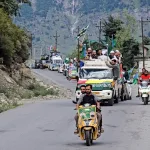RASHID RAINA
Kashmir’s historical record is flooded with major deluges. Two notable points help anchor the memory; 18 July 1893 — continuous rain triggered a major Jhelum flood, contemporary accounts describe 52 hours of rain beginning that day; the valley’s worst flood in a century in 2014 inundated large parts of Srinagar and south Kashmir after days of heavy rain (over 800 km² affected in the valley; Srinagar about 60% submerged with depths up to 16 ft. in some localities).
Chroniclers also note a flood in 1841 that rose higher than 1893 in places, and a sequence of later floods (1950, 1959, and 1992, 2010–2023) that reinforced the valley’s exposure.The global warming induced climate change is further going to exacerbate the problem in near future.
The historical accounts tell us that the loss of life and property from floods in Kashmir was generally lower compared to modern times, even though communities then lacked sophisticated warning systems, technology, or forecasting tools. One caveat is that the size of the population was smaller and their needs far fewer, which naturally reduced exposure. Yet, traditional communities relied on experience, memory, and adaptive practices. Traditional siting, water infrastructure, and building customs in Kashmir evolved through trial and error, treating flood as a recurring phenomenon andnot a rare catastrophe.
Older habitations preferred Karewas (locally vudr)—elevated tablelands and terraces that ring the valley—or slightly raised natural levees along stable channels. These landforms, being higher and better drained than the active floodplain, historically kept homes above routine flood lines. Today, many Karewas are being quarried or built over, eroding this safety margin.
Srinagar’s hydrology once relied on interlinked lakes, marshes and canals that stored and shunted floodwater. Wetlands such as Hokersar, Khushalsar–Gilsar and other marshes soaked up peak flows, shielding upland neighbourhoods. Encroachment and siltation have shrunk their capacity, directly worsening flood impacts. Wetland restoration which includes de-silting, enforcing no-build zones, reconnecting inflows/outfalls is a first-order mitigation.
Nallah Mar canal, a centuries-old navigation/drainage canal that bled excess water from Dal/Brari Nambal through the old city was filled to make a road—now widely acknowledged as an ecological misstep that choked drainage and raised urban flood risk. A modern equivalent linear green–blue corridors that reopen historic flow paths would restore storage and transportation.
In early-20th century Flood Spill Channels diverted Jhelum’s excess from Padshahi Bagh towards Wular. Today, capacity is throttled by siltation and encroachment which requires restoring design discharge and clearing bottlenecks to significantly lower peaks in Srinagar.
Older Kashmiri communities embedded hydrological memory in culture—bridge marks, lores, and chronicles noted flood heights and safe grounds—guiding where to build and where not to. Reinstating visible flood marks and community flood atlases can render that vernacular memory into modern early-warning and land-use practice.
Kashmir’s timber-laced masonry (taq/dhajji-dewari) evolved primarily for earthquakes, but it also helped in floods. Lighter super structures on raised plinths are faster to repair, and timber frames tolerate wet–dry cycles better than heavy RC infill when inundation is shallow and brief. In flood-prone wards, raised plinths, avoiding basements, and designing sacrificial ground floors with wet-proof materials and elevated utilities can help absorb some impact. Architectural sources emphasize the resilience and reparability of traditional systems; planners can adapt these features explicitly for flood.
The 2014 flood mapped neatly onto topography will reveal that low-lying floodplain colonies such as Rajbagh, Jawahar Nagar, Kursoo and Gogji Bagh—largely 20thcentury expansions into flood basins—stayed under water for days.The older, slightly higher quarters generally drained earlier. This is classic “build-on-the-plain, pay-the-price” hydrology.
Land-use must pivot back to flood-compatible uses (parks, sports grounds) in these basins. Satellite/field studies show wetland loss and urbanization amplified depths and duration, while desilted channels and intact marshes eased them locally echoing the traditional sponge-and-channel logic. Studies of Hokersar and Anchar wetlands confirm that their loss amplified flood depths and property damage, underlining how traditional safeguards once provided real protection even if exact statistics are scarce.
Traditional settlements often preserved tree belts along riverbanks and around wetlands, which acted as natural barriers by slowing water flow, stabilizing soil, and reducing erosion during floods. Trees also helped regulate local microclimates, absorbed excess rainwater, and kept groundwater systems healthy—functions that directly lowered the intensity of natural disasters.
This conservation was not always a conscious disaster-prevention strategy but rather a by-product of their way of life, since their economy, agriculture, and livelihoods depended heavily on nature, climate, and its good health. The indiscriminate felling of these trees down for urban expansion has weakened such natural defences, making floods more destructive and landslides more frequent.
Community knowledge also protects people from disasters by turning lived experience into practical survival strategies. In places like Kashmir, older generations passed down memory of flood heights, safe escape routes, and high-ground refuges. This kind of local wisdom helps people anticipate danger even before official warnings arrive. In the 2014 floods, when formal rescue systems, of which I was a part, were overwhelmed, people relied on their knowledge of neighbourhood waterways, traditional boats, and safe highlands/Karewas to evacuate families and livestock, saving thousands of lives.
Such knowledge also guides safer settlement choices and preparedness. Traditional communities often knew which areas to avoid for housing, how to design buildings to withstand water or earthquakes, and how to store food and essentials for emergencies. If embedded into modern disaster management—through community mapping, flood memory markers, school drills, and integration with early warning systems—this collective knowledge would not only reduces casualties and property loss, but also strengthen resilience, make recovery faster and more self-reliant.
In today’s context, despite advanced technology, losses have often been higher because rapid urbanization has ignored those lessons. The key lies in blending the two approaches i.e. embedding traditional knowledge into modern systems. Elevated siting, wetland restoration, vernacular construction methods & community knowledge can work in tandem with modern forecasting, warning networks, and infrastructure planning. Together, they can both reduce the immediate impact of floods and minimize the risk of such large-scale disasters recurring in the future.
(Author is JKAS and Under Secretary /OSD Mission YUVA, Govt. of J&K)







